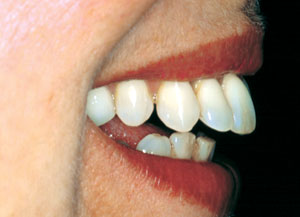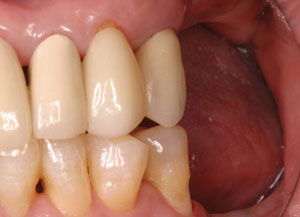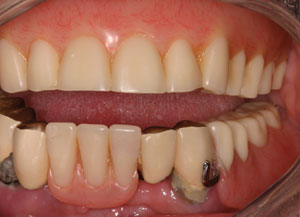Guide to Replacing Partials
The information in the Guide to Replacing Partials provides a comprehensive explanation of the consequences of missing teeth, a comparison of dental implants and partials, and a detailed description of implant procedures. We encourage you to review all of the pages to help you make an informed decision about your treatment options.
Consequences of Missing Teeth and Partials
There are many reasons that people lose teeth over time including, decay, fracture, failed root canal therapy, and periodontal (gum) disease. It can be a frustrating, and often painful process to lose one tooth after another. In addition, a number of significant problems can result from multiple missing teeth including:
- Bone resorption (deterioration) and loss of jaw height
- Adjacent teeth drifting into spaces created by tooth loss or removal
- Teeth in the opposing jaw moving up or down into the gaps created by missing teeth
- Anterior teeth flaring out when posterior teeth are missing
- Cheeks caving in and the corners of the mouth drooping, creating little pockets that can collect saliva
- Excessive wear on the remaining teeth
- Painful dysfunction of the jaw joints.
In the past, when all, or most of the posterior teeth were missing, without teeth on both sides of the gap to secure a bridge, the only treatment option was a removable partial denture. Although the partial provides some function for patients, there are serious consequences that result from wearing partials for an extended period of time, such as:
- Bone resorption is accelerated when partials press down on tissues and compact them
- Hooks put pressure on teeth, resulting in teeth becoming loose and eventually lost over time
- Partials are uncomfortable, rocking back and forth when chewing and often pinching the gums
- It is not natural-looking to have large amounts of plastic with metal hooks, which are often visible, in the mouth
- As the bone melts away, partials must be relined periodically with material to make them thicker as bone melts away
- It is not uncommon to replace partials every 3-5 years
The photos below illustrate the long-term impact of missing posterior teeth and wearing partial dentures.

The bite collapses with several missing posterior teeth and upper teeth move down into the space on the lower jaw

Anterior teeth flare out as they are
pushed forward when multiple
posterior teeth are missing.

Bone resorption from missing posterior teeth is obvious, particularly in lower jaw

Patient’s lower partial replaces all but four remaining natural teeth